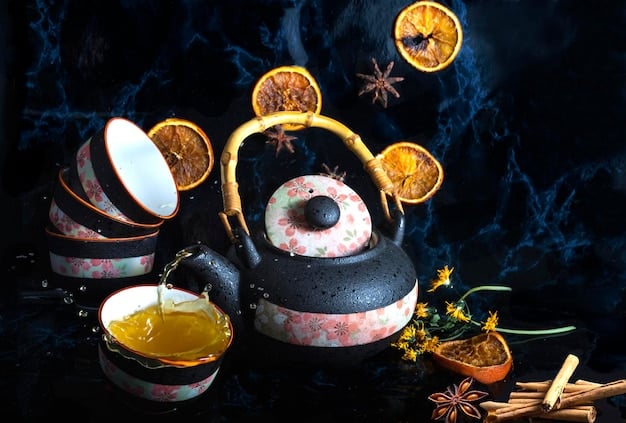Fragrance Families Explained: Your Comprehensive Guide to Finding the Perfect Scent

Fragrance families categorize scents based on their dominant characteristics, helping consumers navigate the vast world of perfumes and find fragrances that align with their personal preferences and olfactory memories.
Navigating the world of fragrances can feel overwhelming. With countless perfumes and colognes available, understanding fragrance families is key to finding a scent that truly resonates with you.
Understanding Fragrance Families
Fragrance families are essentially scent categories that group perfumes and colognes together based on shared dominant characteristics. This classification system helps perfumers and consumers alike to understand and appreciate the nuances of different scents.
By understanding the basics of fragrance families, you’ll be better equipped to identify your personal preferences and discover new fragrances that you love.
The Purpose of Fragrance Families
Fragrance families provide a framework for describing and classifying scents, making it easier to communicate about fragrance and find perfumes that match your individual taste.
- Simplifies the search for new fragrances.
- Helps identify preferred scent profiles.
- Provides common language for discussing scents.
Common Fragrance Families
While there are many variations and subcategories, some of the most common fragrance families include floral, oriental, woody, and fresh. Each family has its own distinct characteristics and appeals to different preferences.
Exploring these families can be a great starting point in your fragrance journey.

Floral Fragrance Family
Floral fragrances are one of the most popular and widely appreciated fragrance families. Known for their sweet and feminine notes, floral scents evoke images of blooming gardens and freshly cut flowers.
This family captures the essence of various blossoms and floral arrangements.
Characteristics of Floral Scents
Floral fragrances typically feature notes of jasmine, rose, lily of the valley, and other popular flowers. These scents are often associated with femininity, romance, and elegance.
- Typically sweet and feminine.
- Evocative of blooming gardens.
- Commonly features notes of jasmine or rose.
Popular Floral Perfumes
Many iconic perfumes fall into the floral fragrance family. These fragrances are often chosen for their ability to evoke feelings of joy, happiness, and romance.
Some examples include Chanel No. 5, J’adore by Dior, and Daisy by Marc Jacobs.
Oriental Fragrance Family
Oriental fragrances, also known as amber fragrances, are characterized by their warm, spicy, and exotic notes. These scents evoke a sense of mystery, sensuality, and opulence.
They have a rich history influenced by Eastern cultures and aromas.

Key Notes in Oriental Fragrances
Common ingredients in oriental fragrances include amber, vanilla, cinnamon, cloves, and other spices. These notes create a warm and inviting scent that is perfect for evening wear.
- Warm, spicy, and exotic.
- Features amber, vanilla, and spice notes.
- Often associated with sensuality.
Example Oriental Perfumes
Notable perfumes in the oriental fragrance family provide an enveloping experience. These fragrances are perfect for those seeking a unique and captivating scent.
Examples include Opium by Yves Saint Laurent and Shalimar by Guerlain.
Woody Fragrance Family
Woody fragrances are known for their earthy, grounding, and sophisticated notes. These scents evoke images of forests, nature, and the great outdoors.
This category often features notes of sandalwood, cedarwood, and vetiver.
Identifying Woody Scents
Woody fragrances are often categorized by their warm, dry, and smoky characteristics. These create a unique and lasting impression. They can be both masculine and feminine, depending on the composition.
- Earthy, grounding, and sophisticated.
- Features sandalwood, cedarwood, and vetiver notes.
- Can be both masculine and feminine.
Popular Choices for Woody Scents
Many woody perfumes and colognes are favorites for their versatility and timeless appeal. These fragrances are perfect for everyday wear or special occasions.
Examples include Terre d’Hermès and Tam Dao by Diptyque.
Fresh Fragrance Family
Fresh fragrances are celebrated for their clean, crisp, and invigorating notes. These scents evoke images of the ocean, fresh laundry, and citrus groves.
This category typically include aquatic, citrus, and green scents.
Characteristics of Fresh Scents
Fresh fragrances are light, airy, and often feature notes of citrus, water, and herbs. These are commonly associated with cleanliness, energy, and revitalization.
- Clean, crisp, and invigorating.
- Includes aquatic, citrus, and greenery.
- Associated with cleanliness and energy.
Options for Fresh Perfumes
Fresh perfumes and colognes are popular choice for those seeking a scent that is uplifting and refreshing. These fragrances are ideal for daytime wear and warm weather months.
Examples include Light Blue by Dolce & Gabbana and Eau Sauvage by Dior.
How to Choose Your Perfect Fragrance
Choosing a fragrance is a personal and subjective experience. Start by exploring the different fragrance families to identify scents that resonate with you.
Experimenting can help you narrow down your preferences and find your signature scent.
Tips for Fragrance Testing
When testing fragrances, spray them on your skin and allow them to develop over time. This will allow you to experience the top, middle, and base notes of the fragrance.
Understanding Fragrance Longevity
Consider the concentration of the fragrance when making your purchase. Perfumes have a higher concentration of fragrance oils and will last longer than eau de toilettes or eau de colognes.
| Key Point | Brief Description |
|---|---|
| 🌸 Floral | Sweet, feminine scents mimicking flowers. |
| 🔥 Oriental | Warm, spicy scents with amber and vanilla. |
| 🌲 Woody | Earthy, grounding scents like cedarwood. |
| 🌊 Fresh | Clean, invigorating scents like citrus and sea. |
Frequently Asked Questions
▼
Fragrance families are categories that group perfumes based on their dominant scent characteristics, such as floral, oriental, woody, and fresh, helping consumers navigate the diverse world of scents.
▼
Try different fragrances and note the scents you enjoy the most. Do you prefer sweet and floral, warm and spicy, earthy and woody, or clean and fresh scents? This will guide you.
▼
Yes, many fragrances are a blend of different families, creating unique and complex scent profiles. These are often referred to as “hybrid” or “fusion” fragrances, adding more nuance.
▼
Higher concentrations, like perfume, last longer because they contain more fragrance oil. Lower concentrations, like cologne, fade faster because they contain less oil and more alcohol.
▼
Spray it on your skin (not clothing) and observe how it develops over several hours. Fragrances have top, middle, and base notes that unfold differently, reacting to your body chemistry.
Conclusion
Understanding fragrance families is an invaluable tool in your journey to finding the perfect scent. By familiarizing yourself with the characteristics of each family and experimenting with different fragrances, you can confidently select scents that align with your personality and preferences.





